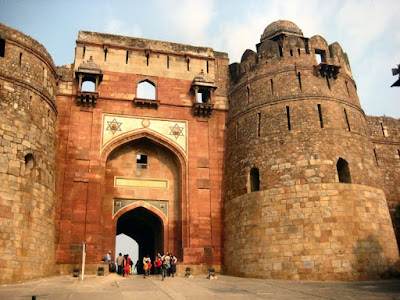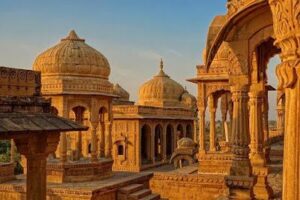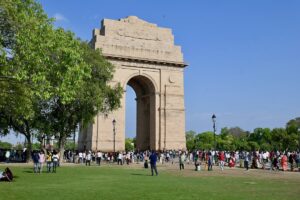19 Famous Historical Places in India Must to Visit
India is full of tourist destinations in all the areas like wildlife, honeymoon places, hill stations, historical places much more. We explored some top historical places in India for family and friends who frequently visit our website.
19 Famous Historical Places in India to visit with family
1. Fatehpur Sikri – Agra
Fatehpur Sikri is located in the west part of Agra and is a very small town that was established in the 16th century by the Mughal emperor. The main reason for its construction was that the emperor Akber’s son Jahangir was born in Sikri village in the year 1569 on the prediction of saint Shaikh Salim Chisti.
This place had the honour to be the capital of the great King Akbar for about 15 years and was later abandoned due to acquit shortage of water. This place is full of affordable hotels and food destinations both vegetarian and non-vegetarian which is also one of the main reasons to attract tourists to this place.
The main points of attraction are:
- Punch Mahal
- Khwabagh
- Lotus Throne
- Tomb Of Sheikh Salim Chisti
- Jama Masjid
- Diwan-i-Aam
- Diwan-i-Khas
- Buland Darwaza
- Johbhai Palace
2. Jhansi – Uttar Pradesh
Jhansi originally was an independent state under the kingdom of the Maratha Newalkar dynasty till 1853, thereafter the British took over it under the provisions of the Doctrine of Lapse. The fame of Jhansi was associated with the name of Maharani Laxmi Bai who played the main role in the Indian Rebellion of 1857.
The flag of Jhansi was a saffron banner the symbol of Hinduism. The known Rani of Jhansi Laxmi Bai popularity called Jhansi ki Rabi was born on 19th November 1828 in the Benares Kingdom of Kashi-Banaras currently known as Varanasi located in Uttar Pradesh, India.
The main points of attraction are:
- Jhansi Fort
- Parichha
- Maharaja Gangadhar Rao Ki Chatri
- Chirgaon
- Rani Mahal
- Government Museum
3. Purana Qila – Delhi
Purana Qila whose real name was Shergarh or Sher Ford is located near Pragati Maidan (the exhibition ground) and is one of the oldest fort forts in Delhi. Its construction was started by the Mughal king Sher Shah Suri. It is supposed to be inhabited about 2500 years ago and its excavations are evidence that its material belongs to pre-Mauryan times.
Its area is about 1.5 kilometres and comprises three gateways – Bara Darwaza, Humayun Gate, and Talaqqi Gate, and all these gates are double stories. Its design is a combination of Rajasthani and Islamic architecture of the Mughal era which made it a heritage site.
4. Dilli Haat – Delhi
5. Qutab Minar – Delhi 
6. India Gate – Delhi 
The map of it is designed by Sir Edwin Lutyens, who also designed the Lutyens Zone, the most prestigious area of Delhi where all the President of India’s residence is situated along with all the central ministries.
This is the outcome of the Imperial War Graves Commission (IWGA) established by the British for the construction of war memorials for the soldiers who were killed in the first world war. It was inaugurated by Lord Irwin in 1931.
Amar Jawan Jyoti also known as the flame of the immortal soldiers is capped by a war helmet, with four urns that are well-equipped with permanent light from compressed natural gas flames. After independence, it was inaugurated by the then Prime Minister Smt. Indira Gandhi on 26 January 1972.
This day is celebrated in India by way of the huge march of defence and states cultural demonstrations at India Gate. The Prime Minister announced to construction a National War Memorial and a National War Museum near it.
Airport Near India Gate: Indira Gandhi International Airport.
Railway Station near India Gate: New Delhi Railway Station, Old Delhi Railway Station.
Ranthambore Fort is situated in the Sawai Madhopur city of Rajasthan in the northern part of India and is located in the Ranthambore National Park.
It is supposed to be built by the Chahamanas also known as Chauhans and was captured by the king of Delhi in nearly the 13th century. This fort was listed as a UNESCO World Heritage Site in the year 2013.
It is not certain who built this fort because of different opinions by the historians as one belief is that it was constructed by the Rajput ruler Sapaldaksha and the other is that it was constructed during the reign of King Jayant.
There are three Hindu temples inside the fort dedicated to the God Shiva, Ganesha and Krishna which were constructed with a red stone of Karauli in about the 12th and 13th centuries.
The fort is divided into two divisions and several temples and holy Stambhas are situated in the western part and the Eastern area is left as the wild area.
The importance of this palace is added by the centre of the trade route between north and central India and therefore, was the best choice of the rulers of the North.
Places of Attraction near Ranthambore Fort:
- Ranthambore National Park
- The Tigress Spa and Resort
- Ranthambore Fort
- Ranthambore National Resort
- Surreal Lake
- Malik Talao
- Trinetra Ganesha Temple
- Raj Bagh Jungle Resort
- Raj Bagh Lakh
- Padam Lakh
- Kachina Valley
- Dastkar Ranthambore
- Jogi Mahal
- Ranthambore School of Art
- Wild Dragon Adventure Park
- Raj Bagh Ruins
- Jeep Safari Ranthambore
- Tiger Reserve
Airport near Ranthambore Fort: Sanganer Airport is the nearest airport and is located in Jaipur city.
8. Umaid Bhawan Palace – Rajasthan
This palace gives the true royal experience because of its architectural splendour and the unique heritage hotel of Jodhpur. This palace was meant for the residence of the former royal family of Jodhpur which consists of about 274 rooms. The beauty of this palace appears to be the magnificent crown of the desert city.
Its construction took the time of about 15 years from 1928 to 1943 and the architects of this palace were Budhmal Rai and Sir Samuel Swinton Jacob who mainly used golden yellow or dun-coloured sandstone to make it an eye-catching structure.
This palace has three divisions used for the residence of the royal family, a museum based on the lifestyle and history of the Royal Family of Jodhpur and a unique Taj Palace Hotel. Out of the total area of about 25 acres, about 15 acres are allotted for beautiful gardens.
The museum of the palace mainly exhibits stuffed leopards, Queen Victoria gave Maharaja Jaswant Singh a large symbolic flag in the year 1877, lighthouse shapes.
Places of Attraction near Umaid Bhawan Palace:
- Umed Garden
- Ramdevra Temple
- Ganesh Temple
- Mehrangarh Fort
- Phool Mandir
- Umaid Heritage Art School
- Santoshi Mata Temple
- Ali Baba House
- Blue Bohemian
- Jodhpur Camel Safari
- Dilwara Jain Temple
- Peace Park
- Machiya Safari Park
- Umed Garden Zoo
- Kota
- JaipurMagic Day Tour
Airports near Umaid Bhawan Palace: Jodhpur Airport (4 km.), Maharana Pratap Airport, Udaipur (126 Km.), and Jaipur International Airport (175 km.) are the nearest airports to this palace. The Summer and the Raily seasons are very dry and humid and should be avoided.
9. Chittorgarh Fort – Rajasthan
Chittorgarh Fort is situated in the Chittor Town in Rajasthan State of the northern part of India at a height of about 180 meters and its total area is about 690 acres. This fort is listed in the UNESCO World Heritage Site and is one of the biggest forts in India.
This fort had the pride to be the capital of Mewar and is so big that it includes about 65 structures which consist of about 19 temples, 4 memorials, 20 water bodies and some towers of victory. This is one of the five Hill Forts of Rajasthan and is in the South Asia Region.
The original name of this fort was Chitrakut. It is supposed that this fort was captured by the Guhila ruler Bappa Rawal but the other thought is that he got this fort in dowry.
According to historians the queen, Padmini was very beautiful and to get Padmini, the Delhi Sultanate ruler Alauddin Khalji invaded Chittor it is said that the queen along with other women committed suicide by Jauhar but this fact is not proven and different historians have their different views on it.
Thereafter the Chittor was assigned to Khizr Khan the son of Alauddin Khalji but actually administered and controlled by his slave Malik Shahin.
This fort is famous due to Maharana Pratap who fought with Akbar a large number of times but never give up against his huge army unlike most of the rulers of Rajputana.
This is one of the main reasons that this fort is a famous point of attraction for tourists from all corners of the world. The Rajput festival known as Jauhar Mela is organised by the Chittorgarh city and the fort annually in memory of all the brave women and queen Padmavati who did Jauhar to save their honour from others who defeat the Chittor.
Places of Attraction near Chittorgarh Fort:
- Rana Kumbha Palace
- Chittorgarh Fort
- Vijay Stambha
- Tower of Fame
- Fateh Prakash Palace
- Rani Padmini’s Palace
- Sanwariaji Temple
- Kalika Mate Temple
- Ratan Singh Palace
- Sathis Deori Temple
- Meera Temple
- Samadhisvara Temple
- Shyam Temple
- Gaumukh Reservoir
- Sita Mata Wildlife Sanctuary
- Bassi Wildlife Sanctuary
- Mandalgart Fort
- Gau Mukh Kund
- Maha Sati
- Kirti Stambh
Airport near Chittorgarh Fort: Maharana Pratap Airport and the Dabok Airport are the nearest airports to this fort.
Railway Station near Chittorgarh Fort: Chittorgarh Railway Station or the Chandeeriya Railway Station is the nearest railway station to this fort.
The Ideal Time to Visit Chittorgarh Fort: October to March is the best time to visit this fort. The summer and Rainy seasons are suggested to be avoided due to heat and humidity.
10. Jaillianwala Bagh – Punjab
Places to Visit near Jaillianwala Bagh:
- Jaillianwala Bagh
- Gurudwara Guru Ka Mahal
- Santokhsar Sahib
- Heritage Shawls
- Dukh Bhanjani Ber Tree
- Gurudwara Lachi Ber
- Central Sikh Museum
- Tourist Hero Amritsar
- The Partition Museum
- Akal Takhat
- Incredible Amritsar
- City of Pedals
- Tempid’Orre
- Khair-ud-Din Masjid
- Durgiana Temple
- Digamber Jain Temple
- Maharaja Ranjit Singh Statue
11. Jaisalmer Fort – Rajasthan
Jaisalmer Fort is the second oldest Fort built by the Rajput Rawal Jaisal in the year 1156 AD and is located in the Jaisalmer city of Rajasthan State in the northern part of India. This is one of the unique Fort in the world where about one-fourth of the old Jaisalmer city population is still living in the fort.
Its architecture is so beautiful that its yellow sandstone walls are of lion colour in the day which converts into honey gold with sunset and due to the fact, this fort is famous as Golden Fort or Sonar Quila. This fort is about 250 feet in height and has covered with about 30 feet long walls.
Inspired by the culture and beauty of this fort the famous Indian film director Satyajit Ray a novel named Sonar Kella and later made a film on it. Due to the story of this movie, a large number of visitors from Bengal and all corners of the world visit this fort throughout the year to assess and experience the aspect of Satyajit Ray portrayed in the movie.
This Fort was included in the list of UNESCO World Heritage Sites along with five other forts of Rajasthan namely, Chittor Fort, Amber Fort, Gagron Gort, Ranthambore Fort and Kumbhalgarh Fort in the year 2013.
They were given the status of Rajput military hill architecture and serial cultural property. This fort is different from other forts of Rajasthan because it houses shops, museums, residential accommodations, restaurants and hotels.
Places of Attraction in Jaisalmer Fort:
- Jaisalmer Fort
- Jain Temples
- Desert Safari
- Gadisar Lake
- Kuldhara Village
- Tazia Tower and Badal Palace
- Sam Sand Dunes
- Patwon Ki Haveli
- Tanot Mata Temple
- Bada Bagh
- Akal Wood Fossil Park
- The Thar Heritage Museum
- Nathmal ki Haveli
- Salim Singh Ki Haveli
- Kuldhara
12. City Palace – Rajasthan
The City Palace is located in the capital of Rajasthan ‘Jaipur’ which was established along with this fort by Maharaja Sawai Jai Singh because he shifted his court from Amber to Jaipur in the year 1727. The main reason for shifting from Amber to Jaipur was the shortage of water which was not available for the daily needs of the people.
Thereafter, the eminent Bengali Architect known as Vidhyadhar Bhattacharya was assigned the work to establish this palace after keeping in view the rules of Vastushastra and for this reason this Palace is one of the most attractive palaces of this state.
This palace was the ceremonial and administrative seat of Maharaja Sawai Jai Singh and the upcoming Maharajas of Jaipur till 1947. This palace is the symbol of prosperity to date because of the home of the Jaipur royal family and is always busy with traditional, culture.
This palace is a combination of European, Mughal and Rajputana architecture and therefore reflects the inherent richness and royalty of ancient India.
Places of Attraction near City Palace:
- Mubarak Mahal
- Maharani Palace
- Chandra Mahal
- Jantar Mantar
- Amber Fort
- Hawa Mahal
- Birla Mandir
- Albert Hall Museum
- Nahargarh Fort
- Galta Ji
- Museum of Legacies
- Amrapali Museum
- Jal Mahal
13. Kangra Fort – Himachal and Punjab
Kangra Fort is situated on the outer side of Kangra and is about 21 kilometres away from Dharamshala in the Himachal Pradesh and Punjab states of the northern part of India.
This fort was originally built by the Rajput rulers of Kangra state by keeping in view its mythological ancient origins of the Trigarta Kingdom the reference of which is also given in the Mahabharata epic.
The temples of this fort were very wealthy because the Hindus along with some others send gold and silver to offer to the presiding deity for earning meritorious karma. Therefore, a heavy amount of wealth is collected in the fort which later became the cause of dispute and attacks by various rulers and others.
This fort was attacked several times by Mahmud Ghazni, Sher Shah Suri and Firuz Shah Tughluq in the year 1009, 1540 and 1360 respectively to plunder the treasures of the temples of this fort. This fort was conquered by various Mughal emperors who were attacked for looting the treasure of this fort which also weaken the Mughal power therefore Raja Sansar Chand II succeeded to conquer the fort.
But at last, taken under control by the British as the result of the Anglo-Sikh war. This fort remains under their control from 1846 till 1905 when an earthquake heavily damaged the fort. The is one of the oldest and largest forts in the Himalayas.
Places of Attraction near Kangra Fort:
- Kangra Fort
- Indrahar Pass
- Chamunda Devi Temple
- Mad Trek Adventures
- Bajreshwari Devi Temple
- Jawalamukhi Devi Temple
- Norbulingka Institute
- Kangra Valley
- HPCA Stadium
- Gyuto Monastery
- Church of St. John
- Shri Kangra Jain Shwetamber Teerth
- Dharamsala War Memorial
- Himveda
- Himari Ganga
- Himachal by Locals
- Aryan Yoga & Reiki Center
- Shiva Temple
- Kunal Pathri Temple
- Kangra Art Museum
Airport near Kangra Fort: The nearest airport to this fort is Gaggal Airport situated at a distance of about 15 kilometres.
Railway Station near Kangra Fort: Pathankot Cantt. is the nearest broad gauge railway station near this fort.
The Ideal Time to Visit Kangra Fort: September to May is the best time to visit this place whereas May and June are not so good due to hot and dry weather but are comfortable.
14. Khajuraho – Madhya Pradesh
Khajuraho Temple is located in the Chhatarpur district of Madhya Pradesh in the northern part of India and is organised and controlled by the group of Hindu and Jain temples known as the Khajuraho Group of Monuments.
The unique Nagara style architecture and erotic sculptures are the main attraction of the temples of Khajuraho which enable them to be on the list of UNESCO World Heritage Sites.
There are about 85 temples in the Khajuraho temple site which is spread over about 21 square kilometres and were built by the Chandela Dynasty nearly 885 to 1050 AD., Overtime only about 24 temples are still in existence and the most famous Kandariy Mahadeva Temple is a symbol of ancient Indian art which is decorated with a profusion of sculptures.
The name of this place is inspired by the word Kharjura which is a Sanskrit word and means date palm. These temples were managed and controlled by different Muslim dynasties from the year 1300 to 1800 and during this period most of the temples were desecrated and neglected for a long time.
These temples were also on the list of Sikandar Lodi’s temple destruction campaign and Muslims continued to destruct the Khajuraho temples which were later revived and overgrown by vegetation and forests over the centuries.
These temples are full of a variety of artwork out of which about 11 per cent is sexual or erotic art both inside and outside the temples. There are different thoughts of scholars about these arts like one thought of scholar says it is a part of the Hindu culture of Karma which is necessary for human life and the other says that it is a tantric sexual practice.
Places of Attraction near Khajuraho Temple:
- MahadevTemple
- Light and Sound Show
- Lakshman Temple
- Kandariya Mahadev Temple
- Vishwanath Temple
- Parsvanath Temple
- Lakshmi Temple
- Archaeological Museum
- Raneh Falls
- Khajuraho Dance Festival
- Adinath Temple
- Varaha Temple
- Nandi Temple
- Chitragupta Temple
- Vaman Temple
- Beni Sagar Dam
15. Hava Mahal – Rajasthan
Hava Mahal built from red and pink sandstone and is also known as the Palace of Breeze or the Palace of Winds is a unique example of Indian architectural beauty not only of its time but till today. This Mahal is situated in Jaipur city, the capital of Rajasthan, in the northern part of India and is about a distance of 310 km. from Delhi.
The temperature of this place becomes very high and these windows and other architectural implements made it pleasant and cool.
The view of this mahal is very illusory as the people looking at it from the street think that its view is on the front side whereas, in reality, it is the backside of the mahal.
Places of Attraction near Hava Mahal:
- Hava Mahal
- Hava Mahal Museum
- City Palace
- Jantar Mantar
- Tripolia Gate
- Sawai Man Singh Town Hall
- Hidden Jaipur
- Jal Mahal
- Nahargarh Fort
- Albert Hall Museum
- Amber Palace
- Jaipur Elephant Ride
- Chandra Mahal
- Gaitor Ki Chhatriyan
16. Amber Fort – Rajasthan
The Amber Fort is one of the points of pride of Rajasthan and is situated in the Amber town of Rajasthan in the northern part of India spread over about 4.1 km. is near Jaipur, the Capital of Rajasthan.
The Meena Community initially built this town and the fort which was later developed and renovated by Maharaja Sawai Jai Singh on the high hill. This fort is the symbol of artistic pattern elements and large ramparts.
The Amer town is now one of the heritage towns of the state and the source of boosting the economy of this town through a large number of tourists who visit here throughout the year from all parts of the world.
Places of Attraction near Amber Fort:
- Jaigarh Fort
- Jagat Shiromani Temple
- Nahargarh Fort
- Jal Mahal
- Panna Meena Ka Kund
- Sheesh Mahal
- Elefantastic
- Maota Lake
- Kesar Kyari
- Sattais Kacheri
- Tunnela inside the fort
17. Red Fort – Delhi
Red Fort is built with red colour stones and consists of an area of about 260 acres. This gem fort was built by King Shah Jahan (the fifth emperor of the Mughal kingdom period. in 1638.
The main reason for its construction was the shifting of its capital from Agra to Delhi. The architect of the Red Fort and the Taj Mahal is the same, legendary Ustad Ahmad Lahori.
This is one of the great construction of Mughal rulers. The main attraction to it steps well, are the Peacock Throne, Moti Masjid, Imperial Bath, and Hira Mahal. The Red Fort was constructed in ten years (May 1638 to April 1648)
In the year 1760, the valuable silver ceiling of the Diwani-i-Khas was removed and melted by the Marathas to raise funds for defence against the battle with Ahmed Shah Durrani. In 1783 the Red Fort was conquered by Sikh Misi Karor Singhania.
It was well renovated by the British under the command of Lord Curzon who ordered the reconstruction of its walls and equipped gardens with a complete watering system.
This fort was made from several prestigious gems, gold, and silver which were looted by Nadir Shah in 1747 and again in 1857 by the Indian rebellion. Now since the independence of India, the Red Fort is the public property under the supervision and control of the government of India.
It is one of the most popular tourist places. Since independence in 1947, the Indian flag is raised on 15th August every year by the Prime Minister of India.
International Airport near Red Fort: Indira Gandhi International Airport.
Railway Station near Red Fort: Old Delhi Railway Station, New Delhi Railway Station.
The Ideal Time to Visit Red Fort: October to Mid-April.
18. Lucknow – Uttar Pradesh
Lucknow is one of the oldest cities in India is having the pride of being one of the capitals of India. The Mughal gateway of Lucknow is in the centre called Rumi Darwaza.
This is the architectural hub in this part of India. The main attraction of this city is traditional chikan embroidery work. The city market in Lucknow is placed in old narrow streets and full of traditional and modern goods and arts.
It consists of a combination of two languages Hindi and Urdu. In the Mughul period, it was the capital of Awadh Pradesh and controlled by the sultan of Delhi. The main famous foods here are Sunday Kebabs, Nihari and Kulcha, Sheermal, Idris Ki Biryani, Nimish, Raja Thandai and much more.
19. Taj Mahal – Uttar Pradesh
Agra the city of precious heritage structure Taj Mahal, is known for being one of the seven wonders of the world. The Taj Mahal and other Mughal period heritage structures are the most popular destination for tourists in Agra. The Taj Mahal is the symbol of love between Shahjahan and Mumtaz, the king and queen.
The main points of attraction are:
- Taj Mahal
- Agra Fort
- Mehtab Bagh
- Agra Art Gallery
- Itmad-Ud-Daula
- Fatehpur Sikri
- Jama Masjid
- Musamman Burj
- Wildlife SOS
- Punch Mahal9
- Sikandara
- Panch Mahal
- Aram Bagh.





















Pingback: 10 most famous adventure sports in India full of thrill